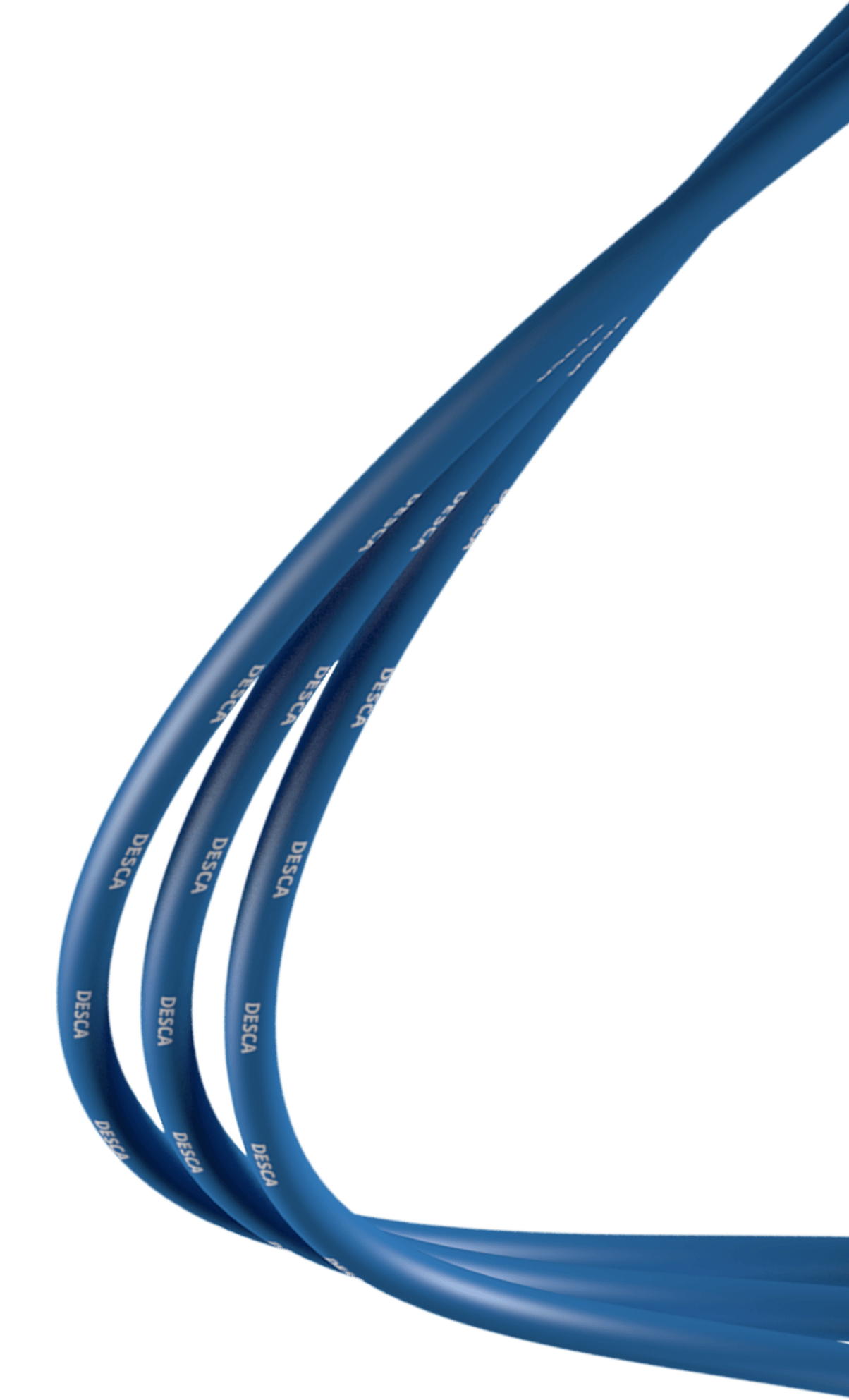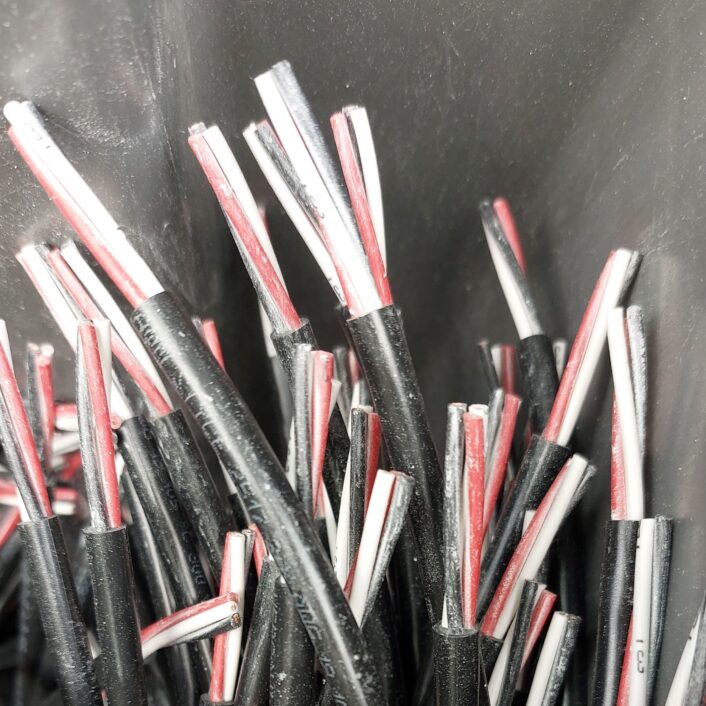
Talc-free wires and cables
Talc-free wires and cables are specially developed for production and assembly environments where particle-free processing, health protection and environmental compatibility are essential, while maintaining the same quality and application as conventional wires and cables. In particular, assemblers and processors as well as companies in the medtech sector and in laboratory technology use talc-free wires and cables to increase productivity. Talc-free wires and cables from DESCA allow stripping and further processing without contamination, soiling of the working environment and health hazards for employees.
Machine strippability of talc-free cables without release agent residue
Talc-free wires and cables are manufactured completely without talcum as a lubricant. Instead, other materials and manufacturing processes are used to achieve comparable effects without using talcum powder. Machine strippability without release agent residues is a major issue. DESCA's talc-free wires and cables offer optimum pull-off forces combined with easy strippability.
Talc-free cables in the production and assembly process and in the working environment
Talcum is a powder that is used in conventional cables to lubricate the cores and facilitate processing. Talc-free cables do not use talcum powder at all. In addition to a clean working environment during assembly, talc-free wires and cables offer a high level of cleanliness and convenience in production. In addition, talc-free cables allow workstations and machines to be kept clean during assembly. Production downtime, high cleaning costs and specific employee protection are massively reduced with talc-free cables. A working environment that is as particle-free as possible and hygienically clean workplaces are becoming increasingly important. The use of talc-free wires and cables is driven by increased requirements in terms of employee health, cleanliness and the reduction of product susceptibility due to dust and contamination.
Alternatives to talcum powder in wires and cables
Textile nonwovens, transparent films and papers are mainly used as alternatives to talcum powder. In particular, kraft paper with virgin paper fibers and a small proportion of sorted waste paper appears to be the most popular.
In the insulation process, it is important that the entire stranding is covered before wrapping. The usual methods are spiral wrapping or covering the cable stranding in cigarette form.
Talc-free cables can be used for all cable types, not just PVC and PUR control cables.
Advantages of talc-free wires and cables
Talc-free wires offer several advantages that can have a positive impact on various aspects of performance, installation and the environment. Here are some of the key benefits.
1. improved reliability and performance
Talc-free wires and cables are often easier to handle. Because they do not clump or clog, they are in high demand, especially in the telecommunications and data transmission industries. As a result, installation time can be shortened and installation errors can be reduced. This can be particularly important when cables need to be installed in tight spaces or around corners.
2. reduced risk of contamination
Talc-free lines prevent contamination of the digits on lines. They also make it impossible to contaminate contacts, which can impair signal quality. The complete elimination of talc reduces the risk of contamination, which contributes to higher cable performance.
3. health benefits
Talc-free pipes and cables reduce potential health risks because alternative and fully human-compatible "lubricants" are used. The environment is not contaminated with particles and talc-free cables can therefore help to reduce the risk of health problems for those who work with the cables or are exposed to the particles.
4. environmental compatibility
The use of talc-free pipes can reduce the environmental impact as talc is a natural mineral that needs to be broken down. Eliminating talc also reduces the risk of environmental damage from the mining and processing of this mineral.
Talc-free wires and cables - the ideal and forward-looking solution
The production of wires and cables without talcum powder is a trend that is beginning to catch on. The future of talc-free cables looks promising and is expected to continue to gain in importance. There are several reasons for this.
1. technological advances
With continued advances in materials science and manufacturing processes, alternatives to conventional lubricants with greater overall benefits are becoming increasingly attractive. In this case, talc-free wires and cables meet the requirements for improved productivity.
2. health and environmental awareness
Due to increased environmental awareness and focus on health issues, companies are increasingly switching to talc-free lines to minimize potential risks to the health of workers and end users and to reduce environmental impact.
3. Regulatory requirements
Regulatory authorities in different countries and regions may impose stricter regulations on the use of certain materials in products such as pipes. This may force companies to switch to talc-free alternatives in order to remain compliant.
4. customer preferences
Converters, assemblers and customers may increasingly ask for wires and cables that are free from unpleasant or potentially harmful substances such as talc. Companies that respond to this demand could gain a competitive advantage and serve their markets more efficiently.
Use of talcum in wire and cable production
In conventional cable and wire production of PVC cables and halogen-free wire insulation and sheathing, the mineral talc in powder form is primarily used as a separating and lubricating agent between the wires and sheathing to prevent the wire insulation from sticking or bonding to the sheathing.
The use of talcum powder enables the sheath to be removed and ensures the flexibility of the wire or cable. This leads to the undesirable side effect that contamination occurs during stripping during further processing, which, in addition to the negative aesthetic effect, can above all contaminate the product itself as well as machines and tools due to the talcum dust.
Use of talc and health effects
In companies that process talc-containing cables, employees in particular are exposed to the unpleasant effects of dust and contamination, which can lead to actual occupational illnesses.
During the processing, installation or maintenance of cables, particles of talcum powder can be released into the air. Inhalation of talc dust can cause respiratory irritation and can be particularly problematic for people with respiratory conditions such as asthma or COPD.
Direct contact with talc can cause skin irritation in some people, especially if they are sensitive to certain substances. This can lead to skin rashes, redness or itching.
Some people may have an allergic reaction to talc. Contact with talc-containing lines can trigger allergic reactions such as skin rashes, swelling or breathing difficulties.
Long-term exposure to talc may be associated with an increased risk of certain health problems, especially if large amounts are inhaled over a long period of time. These include potential risks to the lungs, such as the development of scar tissue (pulmonary fibrosis) or, in extreme cases, the development of cancers such as lung cancer.
It is important to note that the health effects of talc are highly dependent on the amount, duration and degree of exposure. In many cases, proper safety precautions and work practices can minimize the risk of health problems. Nevertheless, it makes sense to use alternative materials to reduce the risk of negative health effects, especially when it comes to products that are in direct contact with people, such as cables and pipes.
Occupational health protection during the processing of talcum-containing cables
Companies therefore install special ventilation systems, dust extraction systems and protective environments to ensure employee comfort and protection. In addition, employees are protected with specific disposable protective clothing and sometimes respiratory protection.
Talc is a naturally occurring mineral that is used in some cables and wires to reduce friction and facilitate handling during installation.
Talc-free conductors can be used in various applications, including telecommunications and data transmission cables, power cables, fiber optic cables and other types of interconnect cables. They offer the benefits of improved reliability, reduced risk of contamination, easier handling and installation, environmental friendliness and improved flexibility.
(c) Copyright Desca AG, 05.04.2024
Avoid particle deposits from wires and cables in the production environment
Particle deposits due to talcum-containing pipes and cables
Here is an illustrative example of the strain that talcum-containing lines can cause in the production process.
Ask the experts about talc-free cables now. Our product managers will be happy to help you.



